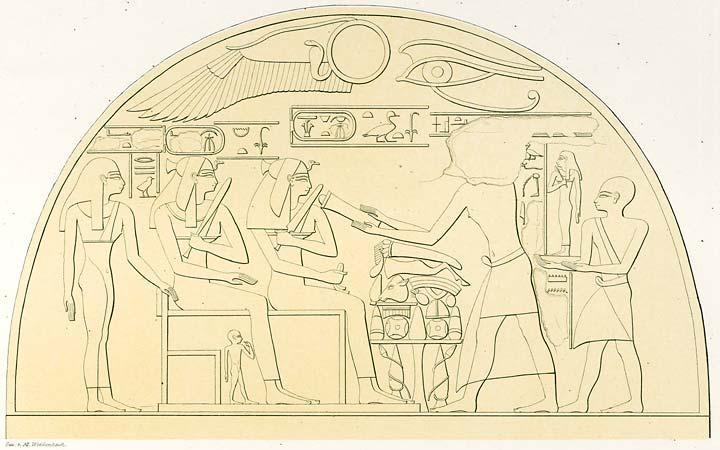Ahmose-Henuttamehu on:
[Wikipedia]
[Google]
[Amazon]
Ahmose-Henuttamehu ("Child of the Moon; Mistress of Lower Egypt") was a princess and queen of the late

 Not much is known about the life of Ahmose-Henuttamehu. The Queen is mentioned on a stela as depicted in Lepsius' Denkmäler.
Ahmose-Henuttamehu's mummy was discovered in 1881 in her own coffin in the tomb
Not much is known about the life of Ahmose-Henuttamehu. The Queen is mentioned on a stela as depicted in Lepsius' Denkmäler.
Ahmose-Henuttamehu's mummy was discovered in 1881 in her own coffin in the tomb
Mummy
{{DEFAULTSORT:Ahmose-Henuttamehu 16th-century BC Egyptian women Ancient Egyptian mummies Queens consort of the Eighteenth Dynasty of Egypt Wives of Ahmose I
17th
17 (seventeen) is the natural number following 16 and preceding 18. It is a prime number.
17 was described at MIT as "the least random number", according to the Jargon File. This is supposedly because, in a study where respondents were asked to ...
-early 18th dynasties of Egypt.
Family
Ahmose-Henuttamehu was a daughter of PharaohSeqenenre Tao
Seqenenre Tao (also Seqenera Djehuty-aa or Sekenenra Taa, called 'the Brave') was a pharaoh who ruled over the last of the local kingdoms of the Theban region of Egypt in the Seventeenth Dynasty during the Second Intermediate Period.
Famil ...
by his sister-wife Ahmose Inhapy
Ahmose-Inhapy or Ahmose-Inhapi (referred to as Anhapou by Maspero) was a princess and queen of the late 17th Dynasty and early 18th Dynasty.
Life
She was probably a daughter of Pharaoh Senakhtenre and was sister to Pharaoh Seqenenre Tao, and t ...
. She was probably married to her half-brother Pharaoh Ahmose I
Ahmose I (''Amosis'', ''Aahmes''; meaning "Iah (the Moon) is born") was a pharaoh and founder of the Eighteenth Dynasty of Egypt in the New Kingdom of Egypt, the era in which ancient Egypt achieved the peak of its power. His reign is usually d ...
, since her titles include King's Wife (''hmt-nisw''), Great King's Wife (''hmt-niswt-wrt''), King's Daughter (''s3t-niswt'') and King's Sister (''snt-niswt''). Ahmose-Henuttamehu was a half-sister to the Great Royal Wife
Great Royal Wife, or alternatively, Chief King's Wife () is the title that was used to refer to the Queen consort, principal wife of the pharaoh of Ancient Egypt, who served many official functions.
Description
While most ancient Egyptians were ...
and God's Wife of Amun
God's Wife of Amun ( Egyptian: ''ḥm.t nṯr n ỉmn'') was the highest-ranking priestess of the Amun cult, an important religious institution in ancient Egypt. The cult was centered in Thebes in Upper Egypt during the Twenty-fifth and Twen ...
Ahmose-Nefertari
Ahmose-Nefertari (Ancient Egyptian: '' Jꜥḥ ms Nfr trj'') was the first Great Royal Wife of the 18th Dynasty of Ancient Egypt. She was a daughter of Seqenenre Tao and Ahhotep I, and royal sister and wife to Ahmose I. Her son Amenhotep I beca ...
.
Life and burial

 Not much is known about the life of Ahmose-Henuttamehu. The Queen is mentioned on a stela as depicted in Lepsius' Denkmäler.
Ahmose-Henuttamehu's mummy was discovered in 1881 in her own coffin in the tomb
Not much is known about the life of Ahmose-Henuttamehu. The Queen is mentioned on a stela as depicted in Lepsius' Denkmäler.
Ahmose-Henuttamehu's mummy was discovered in 1881 in her own coffin in the tomb DB320
The Royal Cache, technically known as TT320 (previously referred to as DB320), is an Ancient Egyptian Hypogeum, tomb located next to Deir el-Bahari, in the Theban Necropolis, opposite the modern city of Luxor.
It contains an extraordinary collect ...
and is now in the Egyptian Museum
The Museum of Egyptian Antiquities, commonly known as the Egyptian Museum (, Egyptian Arabic: ) (also called the Cairo Museum), located in Cairo, Egypt, houses the largest collection of Ancient Egypt, Egyptian antiquities in the world. It hou ...
in Cairo
Cairo ( ; , ) is the Capital city, capital and largest city of Egypt and the Cairo Governorate, being home to more than 10 million people. It is also part of the List of urban agglomerations in Africa, largest urban agglomeration in Africa, L ...
. It was examined by Gaston Maspero
Sir Gaston Camille Charles Maspero (23 June 1846 – 30 June 1916) was a French Egyptologist and director general of excavations and antiquities for the Egyptian government. Widely regarded as the foremost Egyptologist of his generation, he be ...
in December 1882. Henuttamehu was an old woman when she died, with worn teeth. Quotes from the ''Book of the Dead
The ''Book of the Dead'' is the name given to an Ancient Egyptian funerary texts, ancient Egyptian funerary text generally written on papyrus and used from the beginning of the New Kingdom of Egypt, New Kingdom (around 1550 BC) to around 50 BC ...
'' were written on her mummy bandages. She was probably buried together with her mother; her mummy was taken to DB320 along with other mummies after Year 11 of Pharaoh Shoshenq I
Hedjkheperre Setepenre Shoshenq I (Egyptian ''ššnq''; reigned )—also known as Shashank or Sheshonk or Sheshonq Ifor discussion of the spelling, see Shoshenq—was a pharaoh of ancient Egypt and the founder of the Twenty-second Dynasty of Egy ...
.
Ahmose-Henuttamehu is included in the list of royal ancestors worshipped in the Nineteenth Dynasty
The Nineteenth Dynasty of Egypt (notated Dynasty XIX), also known as the Ramessid dynasty, is classified as the second Dynasty of the Ancient Egyptian New Kingdom period, lasting from 1292 BC to 1189 BC. The 19th Dynasty and the 20th Dynasty fu ...
. She appears in the tomb of Khabekhnet in Thebes. In the top row, Prince Ahmose-Sipair appears on the left, and Ahmose-Henuttamehu appears as the fourth woman from the left, after the God's Wife and Lady of the Two Lands Ahmose, and the King's Wife Tures.Kitchen, K.A., Ramesside Inscriptions, Translated & Annotated, Translations, Volume III, Blackwell Publishers, 1996
References
External links
Mummy
{{DEFAULTSORT:Ahmose-Henuttamehu 16th-century BC Egyptian women Ancient Egyptian mummies Queens consort of the Eighteenth Dynasty of Egypt Wives of Ahmose I